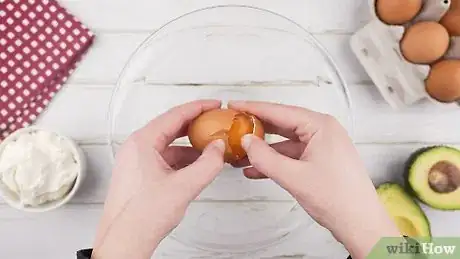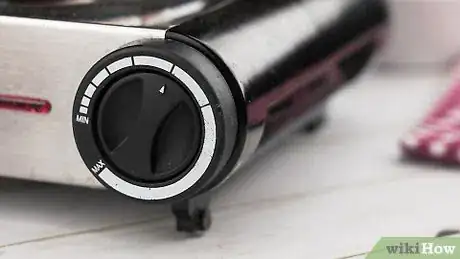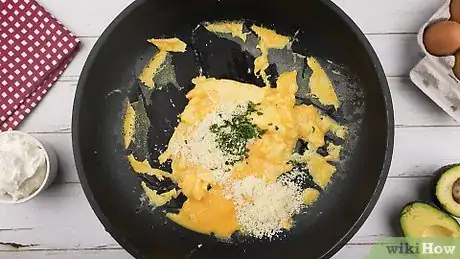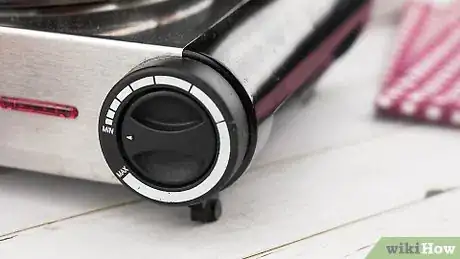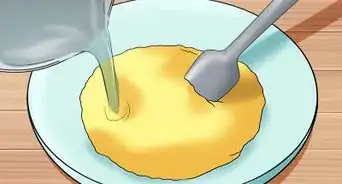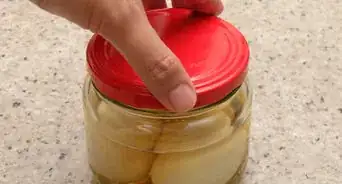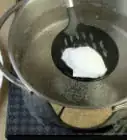This article was co-authored by wikiHow Staff. Our trained team of editors and researchers validate articles for accuracy and comprehensiveness. wikiHow's Content Management Team carefully monitors the work from our editorial staff to ensure that each article is backed by trusted research and meets our high quality standards.
The wikiHow Video Team also followed the article's instructions and verified that they work.
This article has been viewed 263,845 times.
Learn more...
Scrambled eggs make for a quick and delicious meal, but many recipes call for milk. If you are allergic to milk, can't digest lactose, or ran out of milk and need to come up with a substitute, you can still make a tasty plate of scrambled eggs. Add any meat or veggies that you enjoy for a complete and appetizing breakfast.
Ingredients
- 1-2 large eggs
- Any desired other ingredients (vegetables, cheese, etc.)
- Spices or herbs (paprika, thyme, etc.)
Makes 1-2 servings
Steps
Scrambling the Eggs
-
1Crack your egg(s) into a large mixing bowl. Carefully crack the eggs against the lip of the bowl, or against the countertop if the bowl isn't heavy. Pull the shell apart, making sure not to get any shell into the bowl.
- If some eggshell pieces get mixed in with the egg whites and yolks, remove them with a spatula or spoon. You can also use a large piece of eggshell to pull the smaller pieces out of the bowl.
- Some people like to crack their eggs directly into the skillet, but it's better to scramble them in a separate bowl first. It's easier to remove accidental eggshell pieces from a bowl than from a hot pan, and you'll end up with a better plate of eggs if you scramble them fully before exposing them to heat.[1]
-
2Beat the eggs until the whites and yolks are combined. Use a fork or whisk and scramble the eggs together. Make sure that the egg whites get fully combined with the yolks and you don't have any globs or streaks in your liquid mixture.[2]
- If you like denser, thicker eggs, just beat them lightly.
- If very light and fluffy eggs are more your style, beat them longer vigorously to introduce more air into the eggs.[3]
Advertisement -
3Heat up butter or oil in a skillet over medium heat. Most cooks prefer cooking scrambled eggs in butter, but if you're avoiding all dairy products then oil works just fine to keep eggs from sticking to the pan's surface. Add 1 tablespoon (15 mL) of your preferred fat to the pan, and heat over medium heat.[4]
- Use a high-quality nonstick pan for your eggs.[5]
- Don't use a cast iron skillet if possible. The eggs will be much more likely to stick to the pan, and the iron can sometimes give your eggs a greenish tinge.[6]
- It's usually better to use a smaller pan so the eggs don't cook in a very thin layer. A good rule of thumb is to use a 10-inch skillet while cooking 4 eggs, and to adjust accordingly for more or fewer eggs.[7]
-
4Reduce heat to low after the butter or oil is heated through. Your pan is hot enough to add eggs when the butter appears foamy, or the oil starts shimmering. At this point, switch your burner to low or medium-low.[8]
- Cooking your eggs with too much heat will make them dry out, so using a lower heat source will give you lighter scrambled eggs.[9]
Cooking Your Scrambled Eggs
-
1Pour the egg mixture into the pan. Dump the scrambled liquid from your bowl into the middle of the pan. Wait a few seconds to let the eggs start setting at the edges, to help your curds form.[10]
-
2Use a spatula to push the eggs across the pan. Move the liquid from one side to the other, to make sure that they get cooked thoroughly. Your goal is to get all of the uncooked bits of egg to touch the skillet's surface. Stir often throughout the entire time your pan is on your heat source, as this will help the eggs be lighter and fluffier.[11]
- A rubber or silicone spatula works best for scrambling eggs. Using a flexible utensil lets you scrape more easily around the curves of your pan.[12]
- Make sure your spatula is heat-proof so it won't melt into your eggs!
- Tilt the pan as you push around your eggs to make sure that the uncooked liquid eggs touch the surface of the pan.[13]
-
3Add in other ingredients about halfway through the cooking time. When it seems like about half your eggs are cooked into curds or ribbons and the other half is still liquid, dump in meats, pre-cooked vegetables, herbs, or cheese.[14]
- Mix in 2 tablespoons (30 mL) crumbled feta cheese and 1⁄4 teaspoon (1.2 mL) za'atar spice mix for Mediterranean flavors.
- Add 2 tablespoons (30 mL) grated Parmesan cheese and 1 tablespoon (15 mL) chopped basil for an Italian twist.
- Chives are a popular scrambled egg add-in. If you want to add them, mix in 1 tablespoon (15 mL) chopped chives halfway through cooking the eggs.
- Try setting aside a small amount of your extra ingredients to use as a garnish, and top the eggs with the reserved items when you're done.
-
4Start folding the eggs in on each other once you see large lumps form. Once you get thick, cooked curds in your liquid egg mixture, drop the heat on your stove to low. Scoop the eggs up with your spatula and fold them over on top of themselves. Shake the pan back and forth with your other hand to keep the eggs moving around the pan.[15]
- Keep the eggs moving continuously around the pan so that they don't burn.
-
5Add salt and pepper once the eggs are close to being fully set. Many people season their liquid scrambled eggs before cooking, but salt can draw water out of the eggs during the cooking process and leave them tough and watery. Wait until the eggs look like they're about ¾ of the way done, and then sprinkle salt, pepper, and other spices over their surface.[16]
Finishing the Meal
-
1Turn off the heat once there's very little liquid egg left. As you're shaking and turning the pan, keep an eye on how much liquid egg mixture is flowing around the pan. When it looks like the eggs are almost fully cooked and the eggs have firmed up, turn off your stove.[17]
- The eggs will continue to cook a little after they're removed from heat, so stop cooking your eggs when they look just slightly underdone. The cooking process will finish as your eggs sit on your plate.
-
2Remove the eggs from the pan with a spatula and place them on your plate. Alternatively, you could put them onto a piece of toast or a bagel for a scrambled egg sandwich.
- Scoop the eggs into your serving dish as soon as possible. The eggs may get overcooked if they sit around in the skillet, since the pan will retain for a while even after it's removed from the stove.[18]
-
3Sprinkle on any additional garnishes or toppings. If you've added some ingredients to your eggs while cooking, sprinkle on a bit more after the eggs are done and removed to your serving dish. You can also add a little bit more salt and pepper to make sure your eggs are fully seasoned.
- For example, try sprinkling a bit of grated cheese, chopped fresh herbs, or diced vegetables on top of your scrambled eggs.
- Many people like hot sauce on their scrambled eggs. If you want spicy eggs, add several drops of hot sauce on top of your eggs once they're finished.
-
4Let the eggs rest for 1 minute before eating. The eggs will continue to cook a little bit even after you've transferred them to your serving plate. Wait a minute before digging in to make sure the eggs have finished cooking and the heat is evenly distributed throughout your scrambled eggs.[19]
- If you're serving your eggs alongside other foods like bacon or toast, add them to the plate now while you wait.
Community Q&A
Did you know you can get answers researched by wikiHow Staff?
Unlock staff-researched answers by supporting wikiHow
-
QuestionWhy does milk get added to scrambled eggs?
 wikiHow Staff EditorThis answer was written by one of our trained team of researchers who validated it for accuracy and comprehensiveness.
wikiHow Staff EditorThis answer was written by one of our trained team of researchers who validated it for accuracy and comprehensiveness.
Staff Answer wikiHow Staff EditorStaff AnswerIt’s a habit for some cooks, and some people may like how the scrambled eggs taste with milk. Tipping a bit of milk into recipes even when not needed has become a deeply ingrained habit for various dishes (and commercial foods) over the decades. You don’t need to add milk to scrambled eggs, and in fact it’s better if you don’t.
wikiHow Staff EditorStaff AnswerIt’s a habit for some cooks, and some people may like how the scrambled eggs taste with milk. Tipping a bit of milk into recipes even when not needed has become a deeply ingrained habit for various dishes (and commercial foods) over the decades. You don’t need to add milk to scrambled eggs, and in fact it’s better if you don’t. -
QuestionHow do you make scrambled eggs in the microwave without milk?
 wikiHow Staff EditorThis answer was written by one of our trained team of researchers who validated it for accuracy and comprehensiveness.
wikiHow Staff EditorThis answer was written by one of our trained team of researchers who validated it for accuracy and comprehensiveness.
Staff Answer wikiHow Staff EditorStaff AnswerFor a recipe that uses the microwave to make scrambled eggs and doesn’t have milk added to it, see How to Make Scrambled Eggs in the Microwave.
wikiHow Staff EditorStaff AnswerFor a recipe that uses the microwave to make scrambled eggs and doesn’t have milk added to it, see How to Make Scrambled Eggs in the Microwave. -
QuestionCan you make scrambled eggs with water instead of milk?
 wikiHow Staff EditorThis answer was written by one of our trained team of researchers who validated it for accuracy and comprehensiveness.
wikiHow Staff EditorThis answer was written by one of our trained team of researchers who validated it for accuracy and comprehensiveness.
Staff Answer wikiHow Staff EditorStaff Answer
wikiHow Staff EditorStaff Answer
Warnings
- Some people prefer slightly runny scrambled eggs, while others prefer for them to be cooked all the way through. In either case, make sure that the eggs don't "leak" - there's a difference between "slightly runny" and undercooked, and undercooked eggs carry the risk of transmitting disease.⧼thumbs_response⧽
Things You'll Need
- Large bowl
- Mixing utensil, such as fork or whisk
References
- ↑ https://www.southernliving.com/dairy/eggs/scrambled-eggs-with-milk
- ↑ https://www.delish.com/cooking/a20915685/how-to-make-scrambled-eggs/
- ↑ https://www.incredibleegg.org/cooking-school/egg-cookery/stovetop-scramble-eggs/
- ↑ https://www.delish.com/cooking/a20915685/how-to-make-scrambled-eggs/
- ↑ https://pinchofyum.com/soft-scrambled-eggs
- ↑ https://www.incredibleegg.org/cooking-school/egg-cookery/stovetop-scramble-eggs/
- ↑ https://www.bonappetit.com/test-kitchen/how-to/article/best-scrambled-eggs
- ↑ https://www.delish.com/cooking/a20915685/how-to-make-scrambled-eggs/
- ↑ https://www.bonappetit.com/test-kitchen/how-to/article/best-scrambled-eggs
- ↑ https://www.delish.com/cooking/a20915685/how-to-make-scrambled-eggs/
- ↑ https://www.delish.com/cooking/a20915685/how-to-make-scrambled-eggs/
- ↑ https://pinchofyum.com/soft-scrambled-eggs
- ↑ https://www.bonappetit.com/test-kitchen/how-to/article/best-scrambled-eggs
- ↑ https://www.bonappetit.com/test-kitchen/how-to/article/best-scrambled-eggs
- ↑ https://www.foodnetwork.com/recipes/alton-brown/perfect-scrambled-eggs-recipe-2107541
- ↑ https://www.delish.com/cooking/a20915685/how-to-make-scrambled-eggs/
- ↑ https://www.foodnetwork.com/recipes/alton-brown/perfect-scrambled-eggs-recipe-2107541
- ↑ https://www.incredibleegg.org/cooking-school/egg-cookery/stovetop-scramble-eggs/
- ↑ https://www.foodnetwork.com/recipes/alton-brown/perfect-scrambled-eggs-recipe-2107541
- ↑ https://www.southernliving.com/dairy/eggs/scrambled-eggs-with-milk
- ↑ https://www.bonappetit.com/test-kitchen/how-to/article/best-scrambled-eggs
- ↑ https://www.foodnetwork.com/recipes/alton-brown/perfect-scrambled-eggs-recipe-2107541
About This Article
To make scrambled eggs without milk, first crack 1-2 eggs into a mixing bowl. Whisk the eggs until the whites and yolks are combined. The longer you whisk them, the fluffier your scrambled eggs will be. In a skillet, heat 1 tablespoon (15 mL) of oil or butter over medium heat, then turn the heat to low. This will prevent your eggs from drying out. Pour the eggs into the pan and use a spatula to stir them around as they begin to cook. As they cook, fold the eggs and break up large pieces with the spatula. Once the eggs look like they’re nearly done, season them with salt and pepper and turn off the heat. Transfer them to a plate with a spatula and enjoy! For tips on adding vegetables and cheese to your eggs, scroll down!
